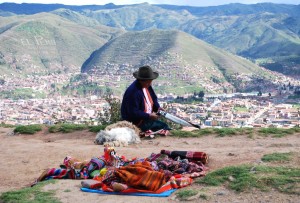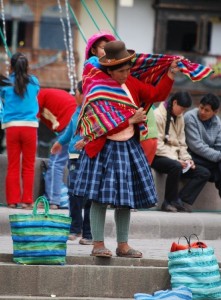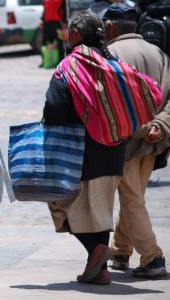Color and Beauty in Cuzco’s Hand Woven Lliqllas,

There are many different ways of artistic expression in the City of Cuzco as well as ways of making your personal feelings known. One of these is weaving rectangular cloths known as lliqllas in Quechua, or mantas in Spanish. Not only are they beautiful, but they are useful. That is why they are also called q’ipirinas, or things to make a q’ipi, a bundle. They are often used for carrying babies and small children as well as your purchases, or other things. But most importantly they are part of many women’s dress. Made in different sizes and beautiful colors they bring joy when they are worn.
The liqlla’s colors make them stand out. Many of them use colors belonging to the rainbow, which is also the flag of Tawantinsuyo, now considered the traditional colors of Cuzco. They also stand out for the decorative figures woven into them such as the cougar, serpent, the condor, and the llama, among others. These animals are part of Cuzco’s culture.
The cloth is woven from the fiber of camelids, such as the llama, alpaca, or vicuña, and of sheep. However to weave a lliqlla you must follow certain steps. In Cuzco, following Quechua, they call this awar, although in formal Spanish it is tejer.

First one must shear the fleece of these animals. It is as if, without hurting them, you took off the attractive sweaters they are wearing. People choose those which have the most wool. After shearing, people sort the wool and select the best. They clean it of impurities.
Then women will spin the wool with a drop spindle called a rueca or pushca. This tool looks a bit like a top with a long stick attached to it. When it is twisted and dropped it pulls the wool and twists it so that the result is a ball of yarn ready for dying. Some children have a lot of fun rolling up the balls. They will have a contest to see who can do it more quickly.


To dye the spun wool, people will use herbs, insects, and some minerals. For example to obtain various reds people rely on cochineal which is an insect that lives on the prickly pear cactus fruit found in teh Sacred Valley of the Incas, around Urubamba and Ollantaytambo. When squeezed a bright red color comes out of the insect. In addition, for yellow we have palillo (turmeric) and for brown we have roble, usually translated as oak. Weavers know how to combine a whole range of plants and minerals in order to get the precise tints of colors they want, especially the ones that are most representative of our land.
Water is boiled over fire in a clay pot, with a little bit of salt and lemon, as well as the coloring agents you are going to use. Finally the wool is added and the whole mass is boiled with constant stirring until the wool takes on the color desired. Once done the wool is dried in the shade so that it will maintain its color.

To weave, awar, as well as the tools you are going to use, like a bastidor (a back strap loom) tied to a tree or a stick pounded into the ground. The other end is tied to your waist. One lays out the yarn for the warp, in the size of the lliqlla you want. One applies tension to the ensemble of threads by pulling backwards. Then you add the hallwas, bars of wood that are grooved on one side and that are the same size as the width of the lliqlla you want to obtain.
Now you begin to weave, using the rokqe, a tool made from deer’s antler shaped into a point. It is used to select the threads you want for your pattern while not letting the tense threads get all tangled. People who weave lliqllas sit on the ground and put into practice their abilities to make elaborate designs with different colors and animal figures so that when finished the beauty of the lliqlla will stand out.

It generally takes about a month to make a good lliqlla because of the attention that must be paid to even the slightest details. As a result, people take great pride in their cloth when they make it and when they wear it or use it to carry children and goods.




